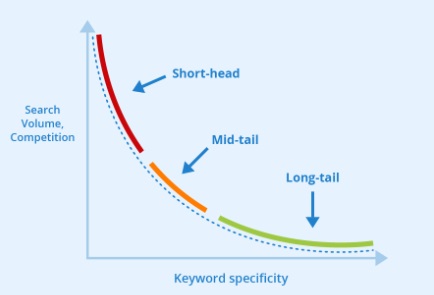How To Drive Traffic To Your Website Using Keyword Research?
Table of Contents
Understanding the Role of Keyword Research in Driving Website Traffic
Keywords play a key role in driving traffic to your website. Keyword research identifies the terms and phrases users search for on search engines. By understanding the role of keyword research, you can optimize your website content to attract relevant visitors and improve your search engine rankings.
One of the main benefits of keyword research is its impact on SEO. By using relevant and related keywords in your content, meta tags, headings, and URLs, you can signal to search engines what your website is all about. Search engines like Google use these signals to determine where your website should rank in the search engine result pages. The higher your website ranks, the more visible it becomes to potential visitors.
Moreover, keyword research can help you identify high-volume keywords that drive significant website traffic. By strategically targeting these high-volume keywords, you can attract more visitors searching for your products or services. This targeted traffic will likely convert into leads or customers, boosting your website’s performance.

Additionally, keyword research allows you to discover long-tail keywords, which are longer and more specific phrases that represent the searcher’s intent more accurately. While long-tail keywords generally have lower search volumes than broad keywords, they often have higher conversion rates because they attract visitors looking for something specific. Adding long-tail keywords into your content can capture valuable traffic from users with clear purchase intent.
Understanding the role of keyword research in driving website traffic is essential for any online business or website owner. By identifying high-volume keywords and utilizing long-tail keywords effectively, you can increase organic traffic, improve your search engine rankings, and drive more valuable visitors to your website. So, conduct thorough keyword research and regularly optimize your content based on your findings to maximize your website’s traffic and performance.
Identifying High-Volume Keywords to Increase Organic Traffic
Importance of High-Volume Keywords
High-volume keywords play a crucial role in driving organic traffic to your website. These are the search terms that users frequently use in search engines like Google, making them valuable for increasing your website’s visibility and attracting potential visitors.
Tools for Keyword Research
Utilizing keyword research tools such as SEMrush, Ahrefs, or Google Keyword Planner can help identify high-volume keywords relevant to your niche. These tools provide insights into search volume, competitiveness, and potential traffic, enabling you to make informed decisions when selecting keywords for your content.
Long-Tail Keywords vs. Short-Tail Keywords
While short-tail keywords have high search volumes, they can also be highly competitive. On the other hand, long-tail keywords are more specific and targeted, attracting users seeking information related to your content. Mixing both types can help diversify your keyword strategy and drive traffic from various sources.
Optimizing Content with High-Volume Keywords
Once you have identified high-volume keywords, strategically incorporate them into your content to improve its online visibility and search engine ranks. Ensure that the keywords are naturally integrated into your titles, headings, meta descriptions, and body copy to signal to search engines the relevance of your content to users’ search queries.
Monitoring and Adjusting Keyword Strategy
Monitoring the performance of high-volume keywords is essential for optimizing your website’s traffic. Track key metrics such as click-through, bounce, and conversion rates to assume the effectiveness of your keyword strategy. Make data-driven adjustments by replacing underperforming keywords with new ones or refining existing ones to better align with user intent.
Identifying high-volume keywords and incorporating them strategically into your content is a powerful way to drive organic traffic to your website. Continuously refining and upgrading your keyword strategy based on performance data can enhance your website’s visibility, attract more site visitors, and achieve your traffic goals.
Utilizing Long-Tail Keywords for Targeted Traffic Generation
Long-tail keywords play a crucial role in driving targeted traffic to your website. Unlike generic short keywords, long-tail keywords are more specific and contain three or more words. By targeting these long-tail keywords in your content and SEO strategy, you can attract visitors more likely to convert into customers.
When conducting keyword research for long-tail keywords, it’s essential to understand your target audience’s search intent. Put yourself in the shoes of your potential customers and think about the specific phrases they would use when looking for products or services like yours. Incorporating these long-tail keywords into your website content can increase your chances of ranking higher in search engine results for your relevant queries.

One of the main advantages of using long-tail keywords is that they have lower competition than generic short keywords. It means that targeting long-tail keywords gives you a better chance of ranking higher in search results and attracting visitors to search for your offer. Long-tail keywords generally have higher conversion rates since they are more specific and align closely with the user’s search intent.
Including long-tail keywords in your content also helps enhance the user experience by providing valuable and relevant information to your audience. When users find the answers to their queries on your website, they are more likely to engage with your site content, stay longer on your website, and potentially convert into leads or customers.
To identify relevant long-tail keywords for your website, you can use various keyword research tools, such as Google Keyword Planner, SEMrush, or Ahrefs. These tools can help you find long-tail keywords with decent search volume and low competition, allowing you to tailor your content to meet the needs and interests of your target audience effectively.
Incorporating long-tail keywords into your SEO strategy is a powerful way to drive targeted traffic to your website. By understanding your audience’s search intent, optimizing your content with relevant long-tail keywords, and providing valuable information, you can attract visitors more likely to convert into customers, boosting your website’s performance and online visibility.
Keyword Mapping Strategies for Improved SEO Performance
Keyword mapping is a crucial aspect of SEO strategy that involves assigning target keywords to specific pages on your website to improve rankings. By mapping keywords strategically, website owners can ensure that their content is aligned with what their target audience is searching for online.
One effective keyword mapping strategy is to conduct in-depth keyword research to identify relevant keywords with high search volumes and low competition. By targeting these keywords, website owners can enhance their chances of ranking higher in the search engine results pages (SERPs) and driving more organic traffic to their site.
After identifying target keywords, the next step is to map them to specific pages on the website based on relevance and search intent. Each webpage should focus on targeting a primary keyword and a set of related secondary keywords to provide comprehensive coverage of the topic and improve the website’s overall SEO performance.

It is essential to create a clear and organized keyword mapping document that outlines the target keywords for each page, their search volume, the level of competition, and the meta tags where these keywords will be incorporated. This document serves as a reference point for content creators and helps ensure the website content is optimized for the selected keywords.
Regularly monitoring keyword performance is critical to making data-driven improvements to the keyword mapping strategy. Website owners can identify underperforming keywords and make the necessary adjustments to optimize their SEO performance by analyzing key metrics such as keyword rankings, organic traffic, and conversion rates.
Implementing effective keyword mapping strategies is essential for improving a website’s SEO performance and driving more organic traffic. Website owners can enhance their search engine rankings and attract valuable organic traffic by conducting thorough keyword research, mapping keywords to relevant pages, and monitoring performance regularly.
Monitoring Keyword Performance and Making Data-Driven Improvements
Understanding how keywords perform is crucial for driving traffic to your website as a website owner or digital marketer. Monitoring keyword performance involves tracking the effectiveness of the keywords you are targeting and making data-driven improvements to optimize your SEO strategy.
One key aspect of monitoring keyword performance is using analytics tools to track the ranking of your chosen keywords. Tools like Google Analytics and Ahrefs can provide valuable insights into how well your keywords perform on search engine results pages (SERPs). By regularly monitoring your keyword rankings, you can identify trends, opportunities for improvement, and areas where your SEO strategy may fall short and need to catch up.
In addition to tracking keyword rankings, analyzing the organic traffic generated by your targeted keywords is essential. You can better understand how users interact with your website by looking at metrics such as click-through rates, bounce rates, and conversion rates for specific keywords. This data can help you identify high-performing keywords driving quality traffic and optimize underperforming keywords to improve their impact.

Another critical aspect of monitoring keyword performance is staying up-to-date with changes in search engine algorithms and user behavior. Search engines frequently update their algorithms to deliver users more relevant and accurate search results. By staying informed about these updates and adjusting your keyword strategy accordingly, you can ensure that your website remains competitive in search rankings and continues to attract relevant traffic.
Based on the data and insights gathered from monitoring keyword performance, you can make data-driven improvements to your SEO strategy. This may involve refining your list of target keywords, optimizing on-page content to better match search intent, or creating new content to target emerging search trends. By continually iterating and improving your keyword strategy based on real-time data and analytics, you can drive more traffic to your site and achieve your SEO and business goals effectively.
Key Takeaway:
In the highly competitive digital world, mastering the art of driving traffic to your website is crucial for success. One of the most effective strategies to achieve this is through a comprehensive understanding of keyword research. Identifying and targeting the right keywords can significantly improve your website’s visibility and attract relevant visitors. This article delves into the crucial aspects of leveraging keyword research to effectively drive traffic to your website. Understanding the Role of Keyword Research in Driving Website Traffic: Keyword research is the key to any successful SEO strategy. By analyzing search trends and understanding user intent, you can gain valuable insights that guide your content creation and optimization efforts. Effective keyword research helps you identify the terms and phrases your target audience uses when searching for information on search engines related to your products or services. Identifying High-Volume Keywords to Increase Organic Traffic: High-volume keywords are search terms that receive a significant amount of traffic. You can attract a larger audience to your website by targeting these keywords in your content. However, balancing high-volume keywords with relevance is essential to ensure that your traffic is qualitative.
Conclusion
In today’s digital landscape, the role of keyword research in driving website traffic cannot be overstated. By understanding the intent behind search queries and leveraging relevant keywords, businesses can attract the right audience to their online platforms. Identifying high-volume keywords is crucial for increasing organic traffic and improving search engine rankings. By strategically targeting these popular keywords, websites can enhance their online visibility and reach a wider audience.

While high-volume keywords are essential, utilizing long-tail keywords is equally crucial for generating targeted traffic. These more specific and niche-focused keywords can help businesses connect with audiences seeking particular products or services. By adding long-tail keywords into their content and optimization strategies, organizations can drive quality traffic that is more likely to convert into customers.
Keyword mapping is another critical strategy for enhancing SEO performance and driving website traffic. By mapping keywords to specific pages and aligning them with relevant content, businesses can create a cohesive and structured approach to search engine optimization. It not only improves the user experience but also signals to the search engines the relevance and authority of the website, leading to higher rankings and increased visibility.
Monitoring keyword performance is essential for making data-driven improvements to SEO strategies. By analyzing key metrics such as click-through rates, conversion rates, and keyword rankings, businesses can gain valuable insights into the effectiveness of their keyword choices. This data can refine existing strategies, identify opportunities, and stay ahead of search trends.
Keyword research remains fundamental to driving website traffic and enhancing overall online visibility. By understanding the significance of keyword intent, strategically targeting high-volume and long-tail keywords, mapping keywords effectively, and monitoring performance diligently, businesses can optimize their SEO efforts and attract a steady stream of relevant website traffic. Organizations can position themselves for long-term success in the competitive digital landscape by staying updated about the latest trends and continuously refining their strategies.



